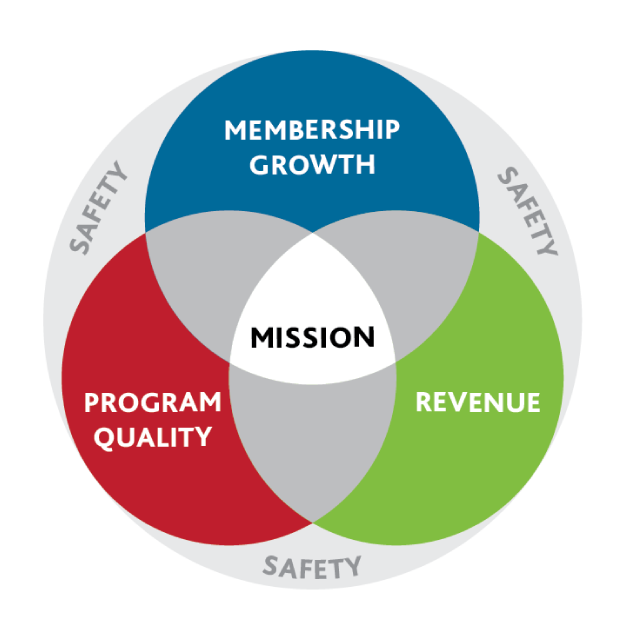| < Overview | Mission Impact | Safety Leadership > |
Our Resources
Policies, Procedures and Standards
| Diversity and Inclusion Policy |
Groups can directly influence Mission Impact by focusing their efforts on a combination of three drivers: program quality, membership and revenue. We can support healthy Groups, enabling even more youth to benefit from Scouting, and ultimately bring to life our Vision of youth making a meaningful contribution to creating a better world.
Program Quality
Through our program, we provide youth with the opportunity to lead their own path to great outdoor adventure and fun. The Four Elements provide members with well-rounded experiences that help them become confident and capable individuals.
Membership
We fundamentally believe that every young Canadian deserves to have access to great Scouting experiences that will ultimately help them achieve success in the world. This means reaching as many youth, parents and Volunteers as possible.
Revenue
As we focus on making an impact on our Mission, it is important that we generate the revenue required to fund great adventures and ensure that Scouting is accessible to anyone who wishes to benefit from the program.
Safety
In addition to the three Mission Impact drivers, Scouting needs to be a place where no one gets hurt. Safety is a fundamental requirement for operations and a requirement for the continued trust of Canadian society.

Our Resources
| Brand Centre |
| Group Commissioners Guide |
Policies, Procedures and Standards
| N/A |
The Group Commissioner’s Role in Membership Growth
Groups should be committed to ensuring that every child has an opportunity to participate in Scouting, and we will work together to meet or exceed an annual 10% growth in full-time youth membership. To achieve this goal, Sections and Groups must engage regularly in recruitment activities and keep a close eye on youth attendance and year-over-year retention. In practical terms, we can exceed our growth goal by adding one youth to each of our Sections across the country every year.
Executing on the other four priorities is a great way to ensure that your Group is well set up for Membership Growth. That being said, with effective planning, proactive Scouters can ensure that as many youth in their community as possible can have great Scouting experiences. Try discussing the following questions at your next Group Committee meeting to help build a recruitment plan for your Group:
- What would each Section need to do to accommodate an additional small team of six to eight youth?
- How can you add more Section Scouters to welcome more youth?
- How can youth in your Group be provided with more opportunities to bring their friends to appropriate Scouting activities?
- How can your Group better reflect the demographics of your community?
- How can your Section meetings be as convenient as possible for families in your community? In what ways do your Sections’ meetings conflict with other popular youth activities?
Group Commissioner Guide to Planning
The Scouts Canada Planning Standard provides the framework and mandatory requirements to ensure a clear cascade of information from National to the Council teams to enable effective delivery on the Five Priorities.
Groups play an important role in the execution of this strategy as effective ‘franchisees’ of the Scouts Canada brand and model. It is the role of the Group Commissioner (GC) to ensure the ‘business of Scouting’ at the Group level is conducted in full alignment with the Scouts Canada brand—including:
- Adherence to the minimum requirements as laid out in the policies, procedures and standards of Scouts Canada;
- That program is offered and delivered according to the requirements of The Canadian Path;
- That Scouting values, member code of conduct and behaviours are consistent with Scouts Canada’s requirements and expectations.
The Role of the Group Committee
The role of the Group Committee in business planning is to ensure that long-term (3–5 years), annual and short-term (monthly–quarterly) plans are in place at the Section and Group level.
What should be included in a Group Plan?
- Risk management and risk assessment (Group and Section)
- Membership (youth and Volunteer)—consideration for community diversity and currently underrepresented populations
- Annual Section Program Plans
- Budget—Group and Section-specific financial requirements
- Fundraising/Revenue Plan
- Human Resourcing Plan
- Canadian Path Implementation—linked to Canadian Path Navigator
- Community Engagement—sponsors, partners, community service
- Scouter performance review, feedback and recognition
| 1. Passive Management | 2. Thoughtful Management | 3. Proactive Management | 4. Management Excellence | |
| Mission Impact | Community engagement and representation are not considered as part of Group operations. | The Group participates in community events and recognizes underrepresented populations. | The Group regularly engages with the community and takes proactive steps to recruit from underrepresented populations. | The Group is viewed as an important local institution; membership strongly represents community diversity. |
| Program and financial business planning is limited; membership growth is not considered. | The Group has an annual business plan which includes program objectives, a budget with fundraising goals and membership targets. | The Group has a three-year business plan where program and Volunteer-support objectives drive fundraising goals; net membership growth is regularly achieved. | The Group has five-year business plan in which program and Volunteer-support excellence drives the budget and fundraising goals; 10% membership growth is regularly achieved. |



